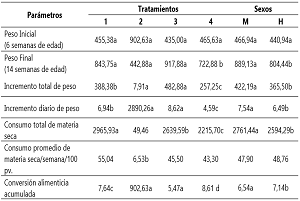Effect of Centrosema (Centrosema macrocarpum) and Nudillo (Brachiaria mutica) on the productive performance of improved guinea pigs in the rearing stage
DOI:
https://doi.org/10.56926/repia.v1i2.18Keywords:
feed conversion, grass, Increased weight, legume, sexAbstract
The objective of the trial was to evaluate the effect Centrosema (Centrosema macrocarpum) and Nudillo (Brachiaria mutica) on the productive performance of improved guinea pigs in the rearing stage. Four treatments were evaluated, T1: 100% Nudillo; T2: 75% Nudillo and 25% Centrosema; T3: 25% Nudillo and 75% Centrosema and T4: 100% Centrosema, using 32 male and female guinea pigs that were distributed under a completely randomized block design with a factorial arrangement of 2 (sex) by 4 (treatment). Differences (P<0.05) were found for weight gains between treatments, with T3 (482.88 g) and T2 (442.88 g) similar to each other and different with T1 (388.37 g) and T4 (257 g). .25 g), in relation to sexes, differences were also found (P<0.01) being the male (422.19 g) superior to the female (363.50 g), also a difference was found (P<0, 01) for the cumulative feed conversion between treatments, with T3 (5.47) being better than T2 (6.53), TI (7.64) and T4 (8.61); similarly, differences (P<0.05) were found between the sexes, with the male (6.54) being superior to the female (7.14). Feeding guinea pigs in the rearing stage with combinations of grass plus legumes reports better results, which is a feeding option for these animals
Downloads
References
Andrade-Yucailla, V., Fuentes, I., Vargas-Burgos, J. C., Lima-Orozco, R., & Jácome, A. (2016). Alimentación de cuyes en crecimiento-ceba a base de gramíneas tropicales adaptadas a la Región Amazónica. Revista Electronica de Veterinaria, 17(1), 1–8. https://www.redalyc.org/articulo.oa?id=63646008003
Calzada Benza, J. (1970). Métodos estadísticos para la investigación (3rd ed.). Editorial Jurídica.
Cantaro Segura, J. L., Delgado Palma, D., & Cayetano Robles, J. L. (2021). Caracterización de la crianza de cuyes en una zona de la sierra de Huarochirí - Perú. Revista de Investigación e Innovación Agropecuaria y de Recursos Naturales, 8(2), 72–78. https://doi.org/10.53287/hffs7980xc24q
Cárdenas Villanueva, L. Á. (2018). Características productivas y tecnológicas de la carne de cuy (Cavia porcellus) utilizando dietas basadas en pisonay (Erythrina sp). Revista de Investigaciones Altoandinas, 20(4), 451–476. https://doi.org/10.18271/ria.2018.422
Choez A., K., & Ravillet S., V. (2018). Frejol castilla (Vigna unguiculata l. Walp) como ingrediente en raciones de crecimiento-engorde de cuyes (Cavia porcellus) mejorados. Revista de Investigaciones Veterinarias Del Perú, 29(1), 180–187. https://doi.org/10.15381/rivep.v29i1.14086
Cruz, D. J., Passuni Huayta, J., Corredor, F. A., & Pascual, M. (2021). Parámetros productivos y reproductivos de cuyes (Cavia porcellus) de las líneas Saños y Mantaro. Revista de Investigaciones Veterinarias Del Perú, 32(3), e20397. https://doi.org/10.15381/rivep.v32i3.20397
Cuibin, R., Zea M., O., Palacios P., G., Norabuena M., E., Collazos P., L., & Sotelo M., A. (2020). Determinación de la digestibilidad y energía digestible de la harina de kudzu (Pueraria phaseoloides) en el cuy (Cavia porcellus). Revista de Investigaciones Veterinarias Del Perú, 31(4), e19020. https://doi.org/10.15381/rivep.v31i4.19020
Huamaní Ñ., G., Zea M., O., Gutiérrez R., G., & Vílchez P., C. (2016). Efecto de tres sistemas de alimentación sobre el comportamiento productivo y perfil de ácidos grasos de carcasa de Cuyes (Cavia porcellus). Revista de Investigaciones Veterinarias Del Perú, 27(3), 486. https://doi.org/10.15381/rivep.v27i3.12004
López A., G., Nuñez D., J., Aguirre T., L., & Flores M., E. (2018). Dinámica de la producción primaria y valor nutritivo de tres gramíneas tropicales (Melinis minutiflora, Setaria sphacelata y Brachiaria mutica) en tres estados fenológicos. Revista de Investigaciones Veterinarias Del Perú, 29(2), 396–409. https://doi.org/10.15381/rivep.v29i2.14494
Meza Bone, G. A., Cabrera Verdezoto, R. P., Morán Morán, J. J., Meza Bone, F. F., Cabrera Verdesoto, C. A., Meza Bone, C. J., Meza Bone, J. S., Cabanilla Campos, M. G., López Mejía, F. X., Pincay Jiménez, J. L., Bohórquez Barros, T., & Ortiz Dicado, J. (2014). Mejora de engorde de cuyes (Cavia porcellus L.) a base de gramíneas y forrajeras arbustivas tropicales en la zona de Quevedo, Ecuador. Idesia (Arica), 32(3), 75–80. https://doi.org/10.4067/S0718-34292014000300010
Ortiz-Oblitas, P., Florián-Alcántara, A., Estela-Manrique, J., Rivera-Jacinto, M., Hobán-Vergara, C., & Murga-Moreno, C. (2021). Caracterización de la crianza de cuyes en tres provincias de la Región Cajamarca, Perú. Revista de Investigaciones Veterinarias Del Perú, 32(2), e20019. https://doi.org/10.15381/rivep.v32i2.20019
Reynaga Roja, M. F., Vergara Rubín, V., Chauca Francia, L., Muscari Greco, J., & Higaonna Oshiro, R. (2020). Sistemas de alimentación mixta e integral en la etapa de crecimiento de cuyes (Cavia porcellus) de las razas Perú, Andina e Inti. Revista de Investigaciones Veterinarias Del Perú, 31(3), e18173. https://doi.org/10.15381/rivep.v31i3.18173
Rodrigo-Condori, N. T., Flores-Merma, H., Ramos-Zuñiga, R., & Cárdenas-Villanueva, L. A. (2020). Perfil bioquímico renal en cuyes (Cavia porcellus) alimentados con pisonay (Erythrina sp). Revista de Investigaciones Veterinarias Del Perú, 31(4), e19249. https://doi.org/10.15381/rivep.v31i4.19249
Yamada A., G., Bazán R., V., & Fuentes N., N. (2019). Comparación de parámetros productivos de dos líneas cárnicas de cuyes en la costa central del Perú. Revista de Investigaciones Veterinarias Del Perú, 30(1), 240–246. https://doi.org/10.15381/rivep.v30i1.15678

Published
How to Cite
Issue
Section
License
Copyright (c) 2022 José Virgilio Aguilar-Vásquez, Alonso Ramírez-García

This work is licensed under a Creative Commons Attribution 4.0 International License.
Authors retain their rights:
a. The authors retain the intellectual property rights (copyright) of the published works, assigning to the journal the right of first publication.
b. Authors retain their trademark and patent rights, and also on any process or procedure described in the article.
c. Authors retain the right to share, copy, distribute, perform and publicly communicate the article published in REPIA (e.g., place it in an institutional repository or publish it in a book), with an acknowledgement of its initial publication in REPIA.
d. Authors retain the right to make a subsequent publication of their work, to use the article or any part of it (e.g., a compilation of their work, notes for conferences, theses, or for a book), provided they indicate the source of publication (authors of the work, journal, volume, number, and date).







